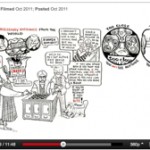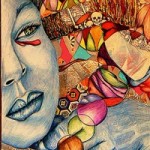Please note that this post has been revised to reflect commentary on Jill Bolte Taylor’s reliance on the right brain—left brain model. See the note at the end of this post.
If you have any interest at all in the relationship between the brain and your awareness of who you are, please go straight to this site. Read the excerpt from Jill Bolte Taylor’s book, My Stroke of Insight: A Brain Scientist’s Personal Journey. Then listen to the podcast of Terry Gross’s interview with the author on Fresh Air. I heard it this morning on the radio, and it’s provided more insight about the human power to heal than all the books and articles I’ve read to date.
Here is the case of a neuroscientist felled by a stroke that wiped out the functionality of the left¹ side of her brain, the center of the faculties for language, analysis, speech. The stroke removed memories of her life, though she knew the information was there – the ability to access it was gone. She couldn’t speak or understand or read words. In many ways, she had become infantile, and with the help of her amazing mother learned all over again how to speak, use language, codify the world.
But the right¹ side of her brain remained untouched, fully functional. That is the center of intuition, associational thinking, the ability of the conscious mind to grasp the whole and to envision reality. Strangely, after her stroke, she felt a powerful euphoria, and that awareness of the state of near spiritual intensity never left her. So during a years-long and difficult recovery, she felt remarkably upbeat and happy, even when she had only a few minutes of energy during the day. Living primarily through right brain experience completely changed her sense of who she was.
As she relearned language and restudied the technical subjects she had mastered before her stroke, she says that she always kept in mind the pictures, diagrams, images that she still remembered and associated with those subjects, even though the words and concepts had disappeared. Slowly she regained the abilities to use abstract reasoning, retain knowledge gained through words, speak and analyze.
With those mental processes functioning again, however, she also found returning a level of tension, anxiety, nervousness and other forms of stress that had once been an all too common part of her life. Now, though, with her strong intuitive abilities and awareness of a different way of experiencing life, she is quick to say: Stop! and to pull back from purely analytical thinking. She finds the balance and rich inner life she depends on by paying more attention to her intuitive self than to her analytic powers.
Though not religious, she has come to appreciate how common among humanity are the spiritual experiences very like the intense euphoria and inner awakening that has been a rich part of her intuitive life since the stroke. She thinks of the world’s religions as the stories people tell to explain the depth and power of these extraordinary moments when a person is lifted out of the realm of the everyday.
These are just a few ideas that struck me in listening to the interview this morning. Hear for yourself, read what she has to say, and let me know if this connects with your experience as deeply as it does with mine.
Note – 7/28/08
¹ Throughout her book and presentations, Taylor relies on the right brain—left brain model to explain the locations of the two sets of faculties that she identifies with two separate voices or personalities within her mind. The use of this model has come under fire from several observers because it is considered an out-of-date depiction of the brain. Current ideas of the location of the specific functions she mentions indicate they are not confined so completely to one hemisphere or the other. See, for example, Chauncey Bell, Dangerous Intersection and a post summarizing such reactions at Idealawg.
It’s also important to read the comments on these posts since several of those criticize two of the writers for missing the point of Taylor’s experience. They point out, and I agree, that the essence of her presentations is not the location of mental faculties in the brain but rather the nature of the inner experience she records.
Image: Some rights reserved by DerrickT at Flickr




Hi
Derrick[John]:I’ve been following the “left brain right brain” controversy for a long time, and I thought you did a particularly good job in your note at the end of presenting a balanced view of it.
So many critics get caught up in the purely neurological critique. In fact, even on that score, neuroscientists are not nearly as clear about the validity or lack of validity of the right/left brain hypothesis. But assuming for the moment the location of mental faculties in the brain is completely different from what Taylor and others have said.
The fact remains, that neuroscientists are often woefully unqualified to make an adequate critique of the psychological distinctions that Taylor, McGilchrist and others are making.
I recently saw an excellent description by neuroscientist/meditation instructor John Yates of selective attention (mediated in part by the left hemisphere, but the right hemisphere is very much involved also) and peripheral awareness (mediated more primarily by the right hemisphere) which tracks the descriptions of Taylor and McGilchrist. Even if Yates is wrong and attention and awareness are actually mediated by the left foot and the right foot (!!), the psychological aspects are still completely in line with what all the other researchers have described – and, perhaps more important to many – in line with what contemplatives and meditators throughout the world have observed for several thousand years.
Thanks for this post, it was very helpful.